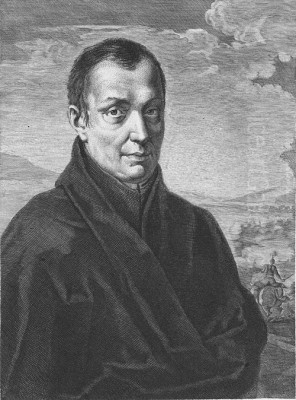
Jacques Courtois, known throughout Italy as "Il Borgognone" and in France as "Le Bourguignon" (both meaning "the Burgundian"), stands as one of the paramount figures in the specialized genre of battle painting during the Baroque era. Born in Saint-Hippolyte, near Besançon in the Franche-Comté region of France in 1621, his life and art became inextricably linked with Italy, where he spent the majority of his prolific career. A painter, etcher, and illustrator, Courtois captured the chaotic energy, brutal reality, and dramatic spectacle of warfare with unparalleled dynamism and skill, leaving an indelible mark on the art of the 17th century. His journey from a young apprentice in provincial France to a celebrated artist in Rome and a lay brother in the Jesuit order is a fascinating tale of artistic development, personal transformation, and enduring influence.
Early Life and Artistic Formation in Italy
Jacques Courtois's artistic journey began under the tutelage of his father, Jean Courtois, who was himself a painter. From the age of fifteen, Jacques received foundational training, likely absorbing the basics of drawing and painting within the family workshop. However, the confines of Saint-Hippolyte could not contain his ambition or his burgeoning talent. Around the year 1637, seeking broader horizons and more advanced instruction, the young Courtois made the pivotal decision to travel to Italy, the undisputed center of the art world at the time.
His initial destination was Milan. There, he found hospitality with a Burgundian gentleman and, significantly, enlisted in the Spanish army, serving for approximately three years. This period of military service proved transformative. It provided Courtois with firsthand experience of camp life, military maneuvers, and the visceral realities of combat. The sights and sounds of the battlefield – the clash of steel, the thunder of hooves, the swirling smoke, the expressions of fear and fury – were etched into his memory, forming the raw material for his future artistic specialization. This direct exposure gave his later works an authenticity and immediacy often lacking in the battle scenes of artists who relied solely on imagination or secondary accounts.
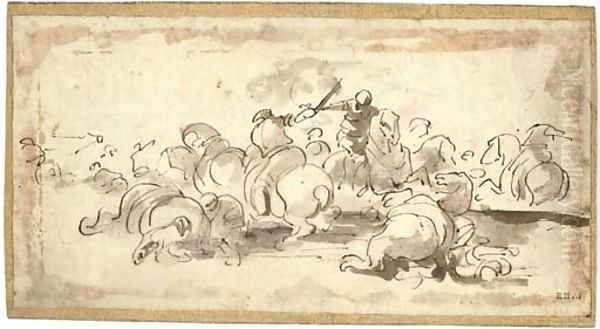
Following his military stint, Courtois dedicated himself fully to art. He traveled to Bologna, a major artistic center renowned for its academy and influential painters. There, he sought out the guidance of the leading masters of the Bolognese school. He is documented as having studied with the celebrated Guido Reni, a master of classical grace and dramatic intensity. Exposure to Reni's sophisticated compositions and refined technique would have undoubtedly broadened Courtois's artistic vocabulary. Sources also suggest a period of study or interaction with Francesco Albani, another prominent figure known for his idyllic landscapes and mythological scenes, though the exact nature of this relationship is less clearly defined than his connection to Reni.
Courtois's artistic education continued in Florence. Here, he reportedly associated with several Northern artists active in the city, including the Dutch painters Jan Asselijn and Pieter van Laer. Van Laer, nicknamed "Il Bamboccio," was the central figure of the 'Bamboccianti,' painters known for their small-scale, realistic depictions of Roman street life and the countryside. While direct collaboration might be difficult to pinpoint definitively, interaction with these artists, particularly Van Laer, could have reinforced Courtois's inclination towards realism and scenes of everyday life, albeit translated into the context of military encampments and skirmishes which often featured in his backgrounds.
Rome and the Rise of the Battle Painter
Around 1639-1640, Jacques Courtois arrived in Rome, the ultimate destination for ambitious artists across Europe. The city was a vibrant hub of artistic innovation and patronage, dominated by the grandeur of the High Baroque. It was here that Courtois's career truly ignited, and he rapidly established himself as a preeminent specialist in battle painting.
A crucial influence during his early Roman years was Michelangelo Cerquozzi, another prominent painter of battle scenes and genre subjects associated with the Bamboccianti. Cerquozzi's lively depictions of popular life and military encounters likely resonated with Courtois's own interests and experiences. Observing Cerquozzi's success and technique may have solidified Courtois's decision to focus primarily on the 'battaglia' genre. He quickly absorbed the Roman artistic milieu, honing his skills and developing a distinctive style.
Courtois's battle paintings were characterized by their extraordinary energy and dynamism. He excelled at depicting the swirling chaos of cavalry charges, the desperate struggles of hand-to-hand combat, and the dramatic interplay of light and shadow across smoke-filled landscapes. His compositions, though often complex and filled with numerous figures, maintained a sense of clarity and narrative force. He possessed a remarkable ability to capture the anatomy and movement of horses, a crucial element in any convincing battle scene. His figures, though small in scale, were rendered with expressive gestures and postures, conveying the tension and violence of the moment.
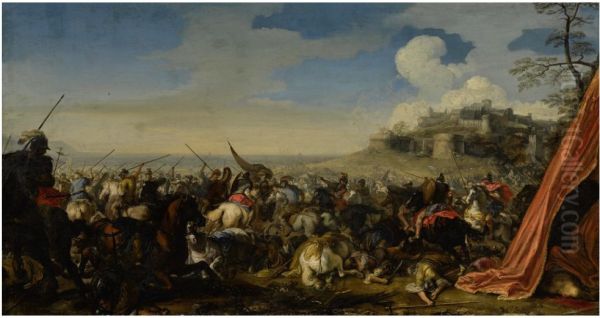
His style was painterly and vigorous, marked by bold brushwork and a warm, often dramatic palette. He skillfully used chiaroscuro effects, contrasting brightly lit passages with deep shadows to heighten the drama and focus the viewer's attention. Unlike the often static and formalized battle depictions of earlier periods, Courtois's work conveyed a sense of immediacy and turbulent motion, plunging the viewer directly into the heart of the conflict. His military background lent his scenes a sense of lived reality, capturing details of armour, weaponry, and military formations with accuracy.
Master of the 'Battaglia'
The 17th century saw a surge in the popularity of battle painting, fueled by the ongoing conflicts across Europe (such as the Thirty Years' War) and the desire of aristocratic patrons to commemorate military victories or simply adorn their galleries with dramatic subject matter. Courtois emerged as the undisputed master of this genre in Rome, surpassing his contemporaries in both skill and output. His reputation spread rapidly, and his works became highly sought after by collectors and patrons throughout Italy and beyond.
His battle scenes, typically executed in oil on canvas and often relatively modest in size, were perfectly suited for private galleries and residences. They offered viewers a thrilling, albeit sanitized, glimpse into the world of warfare. Courtois rarely depicted specific historical battles, preferring instead to create generalized scenes of combat – cavalry skirmishes, infantry clashes, sieges, and ambushes. This allowed him greater compositional freedom and made his works appealing to a wider audience, not tied to specific political allegiances.
The compositions often feature a dynamic interplay between masses of figures and expansive landscapes. A low horizon line frequently emphasizes the turbulent sky, filled with dramatic clouds and smoke from cannon fire or burning buildings. The foreground might present a detailed vignette of intense fighting, while the middle ground shows swirling masses of cavalry, and the background recedes into a hazy, atmospheric distance, suggesting the vast scale of the conflict. He masterfully integrated landscape elements – rugged terrain, distant hills, fortifications – not merely as backdrops but as active participants in the drama, influencing the flow of battle and adding to the overall atmosphere.
While violence is inherent to the subject, Courtois often focused on the energy and movement rather than dwelling excessively on graphic gore. His paintings capture the 'sound and fury' of battle – the charging horses, the flashing swords, the billowing standards – creating a powerful sensory experience for the viewer. His ability to render the textures of metal armour, horse hides, and military uniforms added another layer of realism to his dynamic compositions.
Etchings and Drawings
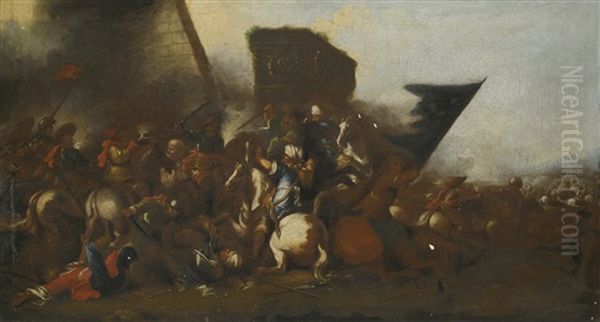
Beyond his prolific output as a painter, Jacques Courtois was also a highly skilled etcher. He produced a number of prints, primarily focusing on the same military subjects that dominated his paintings. His approach to etching was often direct and spontaneous, mirroring the energy of his painted work. It is noted by some sources that he sometimes worked directly onto the copper plate without extensive preparatory drawings, allowing for a freshness and immediacy in his lines.
His etchings, like his paintings, showcase his mastery of composition and his ability to convey complex scenes of movement and action within a small format. They feature similar themes: cavalry charges, marching soldiers, and military encampments. These prints helped to disseminate his style and imagery to a wider audience, further cementing his reputation. The rediscovery or increased attention given to some of his etchings in the 19th century reportedly caused considerable excitement, highlighting their artistic merit and historical significance. His drawings, often executed with pen and wash, also reveal his fluid draftsmanship and compositional thinking, serving as studies for paintings or as independent works. Figures like the great French etcher Jacques Callot, known for his series The Miseries of War, provide a contemporary context for artists engaging with military themes in printmaking, though Courtois's style remained distinctly painterly even in his etchings.
Religious Conversion and Later Life
A significant turning point occurred in Courtois's life around 1655-1657. Following the death of his wife, Maria Vagini, a painter's daughter whom he had married in 1647, Courtois experienced a period of personal crisis. According to some biographical accounts, he was unjustly accused of poisoning her, though this accusation was never proven and is considered unlikely by most historians. Deeply affected by his loss and perhaps seeking spiritual solace or refuge from rumour, Courtois decided to enter the Society of Jesus (the Jesuits) as a lay brother.
He took his initial vows in Rome at Sant'Andrea al Quirinale. Becoming a Jesuit did not mean abandoning his art; rather, it redirected some of his focus. He continued to paint prolifically, often undertaking commissions for Jesuit churches and institutions. He resided primarily at the Jesuit Novitiate of Sant'Andrea and later at the Collegio Romano (the Roman College). His status as a Jesuit brother likely provided him with a stable environment and continued access to patronage networks within the Church.
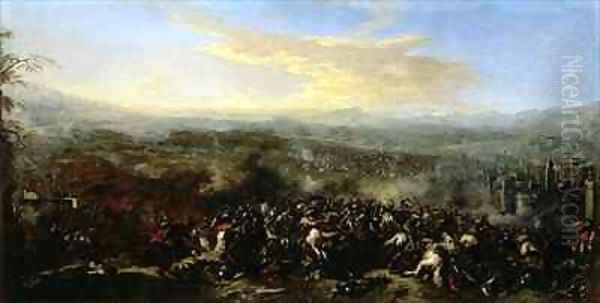
During this later period, while still renowned for his battle scenes, Courtois also produced religious paintings and decorative works for Jesuit settings. He painted frescoes and canvases depicting religious narratives and saints' lives. Works like the Miracle of the Loaves (mentioned as being studied or painted in a Cistercian monastery context, possibly referring to a Jesuit commission or location) and depictions of the Passion of Christ or the Madonna in Battle (a theme blending his specialties) likely date from this phase of his career, though he never entirely abandoned the military subjects that had made him famous. He also continued to paint landscapes, often imbued with the same atmospheric sensitivity found in the backgrounds of his battle pieces.
Patronage, Connections, and Influence
Throughout his career, Jacques Courtois enjoyed significant patronage. His skill attracted the attention of powerful and discerning collectors. One notable patron was Prince Mattia de' Medici, brother of the Grand Duke Ferdinando II of Tuscany. Courtois worked for the prince in Florence, decorating his villa at Lappeggi with frescoes depicting military campaigns, reflecting the prince's own military interests. This commission highlights Courtois's high standing and his ability to secure prestigious projects outside of Rome.
In Venice, he received important commissions from the Sagredo family, prominent Venetian patricians known for their art collections. Creating major battle paintings for such distinguished patrons further enhanced his reputation across Italy. Within Rome, his association with the Jesuits provided a significant network of support and potential commissions. While specific details of extensive direct interaction with figures like the dominant sculptor and architect Gian Lorenzo Bernini are scarce, as a leading artist in Rome and later a member of the influential Jesuit order, Courtois undoubtedly moved within the city's prominent artistic and ecclesiastical circles.
Courtois's dynamic style and mastery of the battle genre exerted considerable influence on subsequent generations of painters, particularly in Italy. His students included the French painter Joseph Parrocel, who spent eight years in Rome and became a notable battle painter in his own right, clearly absorbing his master's style before returning to France. Another follower was Pandolfo Reschi (often confused with 'Parsoloro' in some sources), who successfully imitated Courtois's manner in both battle scenes and landscapes. The Italian painter Francesco Simonini is also frequently cited as an artist heavily influenced by, and sometimes imitating, Borgognone's style.
His impact extended beyond his direct pupils. Artists specializing in battle scenes throughout the later 17th and early 18th centuries often looked to Courtois's work as a model. His compositions were copied and adapted, and his energetic brushwork and atmospheric effects became hallmarks of the genre. He stands alongside other significant painters of conflict and dramatic landscapes like Salvator Rosa and, in Naples, Aniello Falcone, as a key figure who defined the visual language of Baroque battle painting. Joseph Parrocel's son, Charles Parrocel, continued the family tradition of battle painting in France, indirectly carrying forward the lineage influenced by Courtois.
Legacy and Collections
Jacques Courtois died in Rome on May 20, 1676, at the age of 55, residing at the Jesuit Collegio Romano until his final days. He left behind a vast body of work and a formidable reputation as the premier battle painter of his time. His influence was lasting, shaping the conventions of the genre for decades after his death.
Today, works by Jacques Courtois can be found in major museums and collections across the world. The Louvre in Paris, the Uffizi Gallery and Pitti Palace in Florence, the Prado Museum in Madrid, the Hermitage Museum in St. Petersburg, the Kunsthistorisches Museum in Vienna, and numerous other institutions hold examples of his paintings and drawings. His works also continue to appear on the art market, though attribution can sometimes be challenging due to the sheer volume of his output and the number of imitators his success inspired. Many paintings are simply titled Battle Scene, Cavalry Engagement, or Skirmish, reflecting his tendency towards generalized rather than specific historical depictions.
His legacy rests on his unparalleled ability to capture the kinetic energy and dramatic atmosphere of battle. He transformed the genre from often stiff, map-like representations into dynamic, immersive experiences. His firsthand military experience, combined with his artistic training under masters like Reni and his absorption of Roman Baroque dynamism, resulted in a unique and powerful style that defined battle painting for his era.
Conclusion
Jacques Courtois, "Il Borgognone," remains a pivotal figure in 17th-century European art. His specialization in battle painting, executed with vigorous brushwork, dramatic compositions, and a keen sense of realism born from experience, set a standard for the genre. From his early military service to his studies with Italian masters and his eventual entry into the Jesuit order, his life was as eventful as the scenes he depicted. His influence extended through his students and followers, shaping the depiction of warfare in art for generations. As a master of movement, atmosphere, and the dramatic spectacle of conflict, Courtois secured his place as one of the most significant and sought-after painters of the Baroque age. His canvases continue to engage viewers with their turbulent energy and masterful execution, testaments to a unique talent forged in the crucible of art and experience.